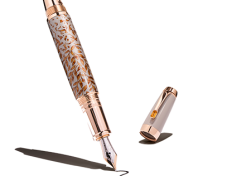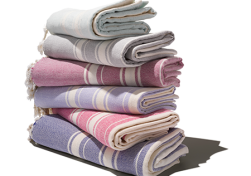This year marks 100 years since Peter Carl Fabergé, goldsmith to the Russian Imperial Court, delivered his last Fabergé Imperial Egg. The Russian Revolution brought an abrupt end to the House of Fabergé, with the artist-jeweler and his family forced to flee Russia. Founded in 1842, the House was famed for the series of Imperial Easter Eggs created for the Russian Imperial Family between 1885 and 1917. The first, the Hen Egg, was commissioned by Tsar Alexander III in 1885 as a surprise for his wife. Crafted from gold, it contained a golden hen and a tiny diamond replica of the Imperial Crown, its presentation inaugurating an annual event that continued for 31 years. In 2007 the company was reborn, crafting exquisite jewelry and watches. Of the 50 eggs Fabergé made for the Russian Imperial Court, 43 have survived, and now the company has revived the tradition, launching a series of Fabergé Four Seasons Eggs. The four-inch-high Winter Egg pictured comprises 6,676 diamonds and 44 aquamarines, and opens to reveal a bespoke jeweled surprise. Definitely a gift fit for an empress. faberge.com
Category Archive: 7 objects
Houseplants were once considered woefully uncool among the young and hip. Anyone with a hectic social life would surely find it impossible to find time for plant-watering, and owning a yucca might hamper one’s ability to jet off to Berlin at the drop of a hat. But now hipsters from Williamsburg to The Mission have embraced the houseplant, with one proviso: it must thrive on neglect. Enter the succulent, a plant that positively demands not to be watered. Succulents come in a dizzying array of shapes and colors, and most evolved with water-storage tissues that allow them to survive in the dry environments with minimal sunlight found in most homes. The most popular are from the Crassulaceae family, like those pictured. And no Williamsburg windowsill is complete without a “terrarium”, a Victorian invention that creates a microclimate for houseplants. New Yorkers can visit Adore Floral to “custom-pair” succulents with stylish vessels, while San Francisco’s Flora Grubb Gardens organizes “potting parties”. The houseplant, it seems, is here to stay. adorenyc.com, floragrubb.com
In January, a 1934 poster advertising alpine resort Gstaad sold at auction for nearly $108,814 – a world record. The sum paid came as a shock even to Christie’s, who had offered a guide price of $15,000. Christie’s holds sales of vintage ski posters twice a year, and the prices have been rising steadily. Originally printed in runs of 1,000 or 2,000, they provide a visual record of the development of resorts from Chamonix to Aspen. London antiquarian bookseller Henry Sotheran Ltd. began specializing in trading vintage ski posters (such as the 1951 poster by Edward Lancaster pictured) ten years ago, and now organizes an exhibition every November. According to Richard Shepherd of Sotheran’s, the posters are growing ever more popular: “They were often thrown away at the end of the season, so few survive in good condition.” The posters typically fetch around $1,000 – and while some buyers are drawn to them for their investment potential, Shepherd puts the posters’ popularity down more to their romantic quality: “They’re a wonderful reminder of a golden age of travel.” sotherans.co.uk
Black food is one of the more unusual trends to hit the blogosphere this year. The seeds of this phenomenon were perhaps planted in 2015 with Burger King Japa’s Kuro Burger, tinted with bamboo charcoal. Since then, culinary mavericks have displayed their own take on the trend, from Melbourne bakery Lune’s squid ink and cumin croissants, to the black ice cream at Morgenstern Finest Ice Cream shop in New York. For most foods, the inky colour is achieved using coconut-shell ash, squid ink or food coloring. In some cases, however, it comes from charcoal powder; there’s even a restaurant in Indonesia, Black Pempek, a “pioneer of black charcoal”, offering several sooty-looking dishes. Of course, enjoying these requires a change of mindset, as our brains have been trained to view black as signifying burnt food. But in the case of one delicacy, the cool factor is matched by health benefits. These black King Soba noodles, pictured, are made from deep purple and black grain rice – rich in minerals and fiber, with a deliciously nutty flavor. Black food… coming soon to a plate near you.
As Vogue reported this year: “No matter how many we encounter, there is just something about a sunset that ignites the imagination. And this has got designers thinking, too; from yellow to fiery orange and cinnamon, there isn’t one color this spring but an ombré of glowing sunset hues. ”After decades in the fashion wilderness, it seems orange is suddenly the color du jour. Sunset hues have been turning up in fashion and interiors features with a regularity not seen since the pop art-inspired days of the 1960s. With color specialist Pantone singling out shades of red as key colors for this year and next, expect to see plenty of bold fabrics. Already spotted on the catwalks of Fendi and Hermès, oranges and warm reds look set to reach their peak in 2017. And the teaming of burnt amber with deep blue – the ultimate sunset combination – was a highlight on the Céline runway and has been seen on prints by Victoria Beckham. This vibrant palette is all about projecting a sense of confidence, action and positive non-conformism. Our guess is, we’ll be seeing more of it. After all, who doesn’t love a sunset?
When Coco Chanel was asked why her dressing table was covered with hundreds of perfume bottles, many of them empty, she replied: “Those bottles are my memories of surrender and conquest, my crown jewels of love.” Surprisingly, commercial perfume bottles are a relatively new invention. In the early 1900s, women would buy fragrance in simple glass containers and decant it into their own bottles (like the 1920s atomizer pictured). The game-changer was a meeting between Parisian perfumer François Coty and glassmaker René Lalique. In 1905 they joined forces and Lalique went on to create hundreds of designs for Coty and other perfume houses. Today, antique perfume bottles, known as “flacons”, have become desirable collectibles.
For London-based flacon dealer Linda Bee of Gray’s Antiques, “the interesting thing is the way they reflect art movements, from Lalique’s art deco creations to Schiaperelli’s surrealist “Shocking!” (1936). Generally speaking though, people’s interest is more emotional than cultural. I get male customers buying a bottle because it was the perfume their mother wore.” lalique.com
In this hi-tech digital age, some families are returning to the simple pleasures of traditional board games. Games like chess and backgammon are often beautiful artifacts in their own right. Auction houses routinely sell antique chess sets for thousands of dollars, while brands like William & Son have carved out a reputation for selling exquisite luxury backgammon sets made from the finest leather or even crocodile skin (pictured). Investing in a luxury board game is something more and more of us are embracing – a fact not lost on design houses. Ralph Lauren Home, for example, has released a games compendium crafted from the finest materials including leather, walnut and silver leaf, while New York’s Bello Games offers myriad figurine chess sets, with themes ranging from the American Civil War to Robin Hood. But the ultimate in statement board games is surely the legendary Ringo Starr Chess Set. Made in 1973 by Asprey, in collaboration with designer Robin Cruikshank, each piece in this sterling silver and gold plated set was fashioned in the shape of Ringo’s hands, right down to the rings worn by the drummer. williamandson.com
For a certain type of person, there is only one type of pen – a proper ink pen. Whether you’re writing a novel or dashing off a note to someone, signing in ink speaks volumes about how you wish to present yourself – which is why it’s vital to own a quality fountain pen. Of course, you’d be forgiven for thinking that email and ballpoint pens might have killed off the fountain pen, but remarkably, sales have risen over the past 10-15 years. And interestingly, while the fountain pen was once considered a masculine accoutrement, brands are increasingly designing them with women in mind – like this Bohème Doué Moongarden from Montblanc, which boasts a handcrafted retractable gold nib and a sinuous lacquered red gold-colored pattern on the barrel, inspired by tree leaves at full moon. So why exactly is the fountain pen holding its own? Perhaps it’s because it represents a nostalgia for an era when people took time to do things right, when the personal touch mattered. After all, which would you rather receive – a hastily sent email or a note written in flowing indigo ink? montblanc.com
Earlier this year, U.S. Vogue posed the question: “Are vegetables the new meat?” Veg is all the rage right now, it seems, and not just for the usual health-conscious, save-the-planet reasons – but because it tastes great And yet there is still a nagging sense that however imaginatively prepared, cabbage or kale will never inspire the same excitement as a juicy steak – that vegetables will always be doomed to play a Best Supporting role. Enter the Romanesco, a vegetable so visually arresting, it demands top billing. Somewhere between a broccoli and a cauliflower, its tightly packed lime-green florets are an example of phyllotaxis, a naturally occurring fractal pattern. Once only to be found in farmers’ markets, Romanesco’s popularity is growing fast, thanks in part to high profile advocates like Michelin-starred chef April Bloomfield. Anyone considering giving Romanesco a whirl would be well-advised to follow Bloomfield’s advice: “Pop it into a heavy bottomed pot with some fresh rosemary, salted anchovy and tomato, roast until tender and aromatic. Just perfect.” aprilbloomfield.com
Canadian Jennifer Gaudet, founder of Jennifer’s Hamam in Istanbul’s Arasta Bazaar, is a passionate defender of Turkey’s vanishing textiles tradition. Thankfully her mission has been boosted by the global popularity of the hamam towel or pestemal – a compact and lightweight towel that’s highly absorbent and dries five times quicker than regular towels. “The hamam towel is something very special in Turkish culture,” she says, “because the hamam is very special. It wasn’t just a bathhouse, it was a communal meeting place. Visiting the hamam was a daily ritual. Over the centuries, Turkish women took this functional item – the towel – and transformed it into a thing of beauty.” Istanbul now boasts hundreds of stores selling a vast array of towels. And with pastels gracing catwalks this season, pestemals like those pictured (from Ailera) are sure to go down a storm. Best of all, when you’re not on holiday, they have a variety of other uses. “People use them as tablecloths, throws, curtains, scarves or shawls,” says Gaudet. “The only limit is the owner’s inspiration and imagination.” jennifershamam.com; ailera.com









